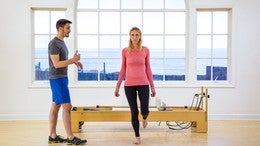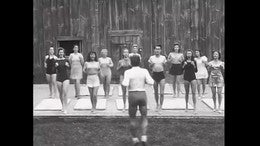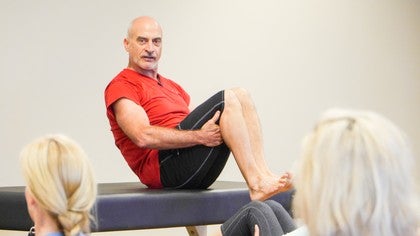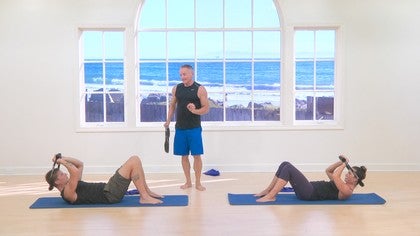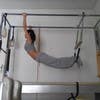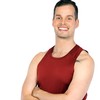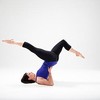Description
This class is a continuation of Juan's Lower Extremities workshop. You can also watch his assessment to learn what you can do help avoid or help common injuries.
Special footage generously included in this class from Pilates Elder Mary Bowen's Historical DVD.
About This Video
Transcript
Read Full Transcript
Okay, so welcome. We're gonna do a movement class and it's 100% lattice class and probably not the typical, the successes that, you know, so this, this class is inspired in, in some footage that exists or your [inaudible], uh, working outdoors. Um, what is was, what it was really interesting to me is that, uh, it's a complete different attitude and complete different set of exercise and flow, uh, that you can see when he was moving then when he was teaching. Okay. Um, and everything is necessary and everything is important, but I think we should be like reclaiming, claiming these movements like crawling and hen stance and a little bit of wrestling and, uh, partnering, um, which are really, really interesting. And it looks like there's something else. It's not [inaudible], but, uh, actually your bladder's practice this, this kind of exercise. Okay. So let's go, let's go. [inaudible] so one of the things that is really interesting to see is that he started all his classes with some plyometrics and saw activation, um, for the buddy. So we're gonna start bouncing. Okay.
Well actually most of the job he has, his classes started like this. Okay. Okay, good. So now this is what I wanted to do. We're going to do a stand in, roll down. Okay. So we're going to start with the hair.
So really is now to go forward. To go up. Sorry. I want you to take the pelvis forward. If the pelvis go forward. You BARISTA rolling up. Alright. So we're gonna start from the head, neck, chest, and when you feel that the is naturally shifting back, let it happen. But at the same time, let the movement in the spine continue.
And then when we go up, you think in your sacrum, in your pelvis, moving forward.
Show the blades. So again, instead of doing the movement, so linear, are we going up with the same motion? We are creating movement in different places, different joints. It's not so linear. Okay. So we're going to do it again. Okay. And when do you see GOP lat is doing this kind of patterns? He just do it. He just is not thinking about moving. He's using the pattern to go into, crawl on going up and down. So this is what I want you to do. Okay?
So we're gonna roll down and I want you to take your hands on the floor, okay? And make sure that you have crests between each other, that you have space. Because I want you to move one foot forward
If you need to bend your knees, you can do it. If you cannot lower your heels, that's completely okay. And now we're going to focus in not using the knees nor the elbows. So no knees, no elbows. That's it. Good job. Okay, so now we're gonna face each other again. All right? So, so this is something that that Joe [inaudible] would use as a warmup and it could be very challenging for us, but actually it's, it's a very good pattern to, to work. It requires quite a lot of, uh, features in our body that we need to have. Okay? So we're gonna keep playing on this. Bear crawling.
Now I want you to do two fit or, or two hands at the same time. So instead of doing one, two, three, four, we're going to do
Okay, fantastic. That's it. That's it. Joe. The ideas that you eventually use it. Okay, so what about, let's do another round. We're going to do ipsilateral foot and hand from the same side and try to coordinate. That's it. Try to coordinate how to distribute the weight at the same time. Brianna, that's it. Four points. Two points. That's it. Four points. Two points. Good job. Okay, so now when you see how bill had his do it, he was using like very playfully. So I want you to start, use it as crawling and I want you to start fighting each other, not fighting, just to create a little booze. Get into the way. Okay, so let's go in the middle with some moving. Okay, let's go. That's it.
That's it. Alright. Mers around. Push each other. Don't be very polite. Okay. Okay. I love people laughing on the classes, so, so that's, that's fantastic. Okay, good. So let's go to the quarterback position now. Okay, let's do a little warmup.
So try to take your hands and
But make sure that we have room there in the, in the elbows and the shoulder. Okay? So when we rotate out, I want you to let the sternum go down. So we're gonna try to create a little bit of thoracic extension. And again, when you feel that there is no more room, there's probably more. So keep going and going and going and going. So the chest goes forward, the shoulder blades retract. And now we're gonna do the opposite.
We're going to do our protraction. So the sternum goes up into the ceiling and the shoulder blades go really, really, really spread out into [inaudible] traction and no extension and retraction. That's a uh, protraction and just the little bit of flection in the thoracic spine. Fantastic. Okay, let's go to one side now. So we go to the right side. Protraction, extension, retraction, extension, Seri, protrax, inflection change to the other side. Retraction, extension, good job, protraction, flection. And two, the first side retraction. Make sure that the elbows, they extended protraction and flection and to the other side we go into retraction and extension. Good job. Great.
So let's go to the center. We're going to [inaudible] a little bit of protraction. Okay. And now what I want you to do is to move the head forward. So try to face your face in front of the hair floor, like, you know, looking up or down. But make sure that you keep some sort of protraction. Okay.
So it's very easy to do this or it's very easy to do this. This we are very used to and this is what we consider our bad posture. But creating this pattern is not the same as this pattern. Okay? So what I want you to do is to keep the protraction and go forward and now or now create a posterior translation of the head.
So we go back, back, back, back, back, doing a lot of extension, keeping the chin and the nose down, keeping protraction and now forward. So those are joints that they need love too. They need movement and we never use and then back back and press. Fantastic. Okay. One more thing because we are going to be using a resident.
The rest if you, if you need make little circles or just shake it. Um, if you watch the, the original politesse are material that exist. Uh, it was really interesting to me to see how much neck and head exercise he used. And it's completely forgotten that we don't use any neck exercise, but he was doing quite a lot of exercises using their head and, and challenging and, and conditioning the neck. Okay. So we're going to try to do a couple of exercises that we can, we can use the head during, during the class. Okay. So a little warm up from here.
I want you to take the head so elbows down now and I want you to rotate with a little bit of weight. As soon as you feel uncomfortable or something like that, just stop. But most of the times we'll be our expectations and you'd be okay. Okay. So it's okay. We can get a little bit of flow and get the tin closer to the sternum.
That's okay. And I want you to look at one of your armpits and do the same. Roll forward with a little bit of weight over your head and look to the other side.
Good. No painful nor dyskinesia. We don't need to go to the hospital. That's good. Okay. Sometimes we don't do things because we are scared of doing it. But our body, our neck, everything is usually more resilience that we think. And it's okay to keep that good to keep it that way. I keep doing things like that. Okay. So, uh, we're going to keep playing with this. So from there quite a bit position.
Make sure that you get your toes on there. If you can. I want you to press forward and sit into squat. Good job. Fantastic. So we go down hands and lower. So we go back and sit. Great job. And then forward and slowly. Great job.
Now we are gonna continue from here.
So this position and wow, you're moving to Mason. So we're going to play with a full squat into standing. So it's a pattern and something that Joe Bilott is did quite a lot of times. So we're going to start with a fit center rotated and the prisoner hands, which is, this is the typical job [inaudible] image. So I want you to go into your toes and I want you to focus on the heels. Okay?
So try to keep pressing the heels together and make a little bit of pressure towards your hands. So we're going to do a couple of heel races, keeping the hills together. So just the slight pressure in the hair. That's it.
And by doing this exercise this way, because if you have the feedback of your hips of your heels, you are definitely engaged in a bit more muscles that we're going to help you. So the big, big glutes are going to help you. And also here, this is going to encourage Accella longer [inaudible] and a little bit of support back. So when the body wants to go there, you have a little point of support to create more stability. So we're going to do it again. So we press back hills together and we keep it that way and we go all the way down heels. Fantastic. And then we go up. Good.
So now parallel, let's see how it works. So you can keep your hands or not. And then we go down.
And one more time heals down, down. So now we're here, we kneel down like this. Okay. So you can use the buddy to compensate. So to come back, really need to take the hips really, really into the socket. And if we want to lower the heels that we want, we're going to use the body way to move forward.
If you need to open your feet, that's okay. Alright, so from there is that pelvis again who is taking movement forward and compensating with the shoulders? We go back and then we go back again and then use your body weight to get forward and then we go up. All right, good. Uh, another way of, of doing the exercises, not using the hips. So even though a lot of people do the squats, using very little of the hips, when you completely avoid the movement in the hips, they realize, we realize how difficult it is to do the exercise without the hips. So, but if you look at the politesse footage he used this are now it's called like the CC squat quite a lot. So, um, the sister squad is going down with the hips. Completely standard. So we're going to prepare during the side streets. So we're going to go down just like you want.
So we go down here and from, from this position, I want you to take the pelvis forward. Okay? So it's really important that the front of the hips and the hips are really low here. Not here is the forward is the part that is going forward and you keep pressing down with the toes. Okay? So if you want to check the ribs, we can cross the arms and I wanted to lean back. That's it. So another thing that you can do is to think in opening and lifting the front of the pelvis and taking the ribs back. And let's do it again.
So this sensation is what you want to find when we explore the sissy squat. Okay? So it's more like trying to do the thighs, stretch that going down. So he goes [inaudible] and up. So I don't want to do it due to do it all the way down. I want you to explore. So open the hips, going back, back, back like you were doing a fast stretch. No battle at all. Scary. Good job. Good. Try.
And then add. So we're gonna do it again. Again, it's an exploration, so you can do, it's not right or wrong, it's just a discovery. Okay. So Matt for me really helps. This really helps the thing that I'm doing a fast stretch plunk. Tell them much better. And then we see and then we go up. Okay, fantastic. So we're gonna see.
All right. And we're gonna roll into, into the supine position. I don't, I don't want to see like a very perfect roll. Rolling. Like a ball exercise. I just want you to roll and I want you to roll with the intention of going into standing. Okay? So if the head that is the floor a little bit, and if it's controlled, and if it's not a big hit, it's okay. It's, it's not gonna get an injured. Okay. But make sure that you use in your spine and your buddy to roll forward with enough energy to pull your weight over your feet. Okay.
And then we're going to stand up. Okay. And we can stand up with Aleks. Gross or parallel or one leg you explore. Okay. So let's roll a couple of times. And when do you feel you have enough energy? We are going to stand up. Okay, let's go. So roll. Good job. Okay. So with this position we roll and you can explore something different.
Great job. And again. Okay. And start thinking less and less and less.
If it's too far away, you can really press maybe if it's too close, it's difficult, uh, something that is comfortable for you. So the arms to the sides. And I want you to focus in different parts of pressure. Okay? So first thing is I want you to lower the lower ribs, just the lower ribs. And at the same time that we create a little bit more pressure in the lower ribs, I wanted to press with the fit.
So you barely feel that the pelvis is lighter and then your wrist. So we start the exercise by lowering the lower ribs, pressing with the fit and let it, the pell, let the pelvis lift a little bit. So now that we have this kind of a preparation, we're going to start rolling the pelvis into the bridge position. So lower ribs down, feet down, open the front of the hips, and then length in the sacrum between the knees and make sure that you keep enough supports into the, into the rips. And then we're gonna roll slowly. Okay. So this is the typical Brits that we, we'll do one more time and we progress it.
So lower rips down, fit down, open the front of the hips, make sure that you keep pressing in the lower ribs, and then the fit. And I want you to transfer the weight into the back of the shoulders, into their triceps on the deltoid. I want you to start pressing with the arms down there. So the sternum cans start extending and moving towards the chin. So shoulders, back, shoulder blades kind of retracted.
Sternum into the chest, into the chin, sorry. And keep pressing with the fifth down. Open the front of the pelvis, pelvis up, sternum to the chin, arms back, and then roll. Very slowly. Try to lengthen the spine as much as you can.
Let gravity to create the motion. Okay, cool. So now we're creating movement somewhere else. If it's scary for your neck or if you have any pain, uh, to enjoy it or we can modify, but I, but usually one, this movement will have any impact, negative impact in your, in your neck. So we're going to do it again. So lower ribs down, press with the fit. Open the front of the pelvis, length in the front of the hips. So now transfer the weight into the arms, sternum towards the Chin retraction, hip extension.
Press with the toe with the foot and keep opening, opening, opening Elvis up, sternum towards the chin. Use the legs, feel the fit, and then slowly rolling with every segment if possible. [inaudible] okay, great. So now, next progression. Let's take the hands to the side. So some people are more comfortable like this or more like that. So do decide. Okay, same idea. Now we're going to put some weight in the top of the head so we're not lifting too much.
I want you to on purpose roll a little bit on the head. Okay. So I want you to roll the head on the floor, but don't pull enough weight or too much weight. If you feel there's something dangerous or, or the neck is sensitive, but usually it's not. Okay. So lower ribs down, feet pressing down. Open the front of the hips, the sacrum towards the knees. And now I live the sternum up, sternum towards the chin. Keep pressing with the foot. Hips forward and up.
So now when you are really, really, really high, this, just press a little bit with the arms and let the head roll. Keep some weight on the head. That's okay. But make sure that the thoracic spine is really, really well aligned on top of the head and a rollback. Keep Rolling. Rolling. Rolling. Rolling. Rolling. How is it? Can I see it? Okay, let's do it again.
So lower ribs back, pressure on the feet. Open the front of the hips, not so fast in. Okay. Sternum up, sternum to the chin. When you feel that the whole body is prepared, that it makes sure that you put the thoracic spine over the head. That's it. And then we roll back. Job. Good. Have good use of the legs. Fantastic. And from there, if we have been achieving every step, we can go into the complete hybrids. So we're going to do it one more time. One, one time. Okay. But make sure that everything is happening. So every phase is important. Okay. So let's go lower rips fit. Open the front of the pelvis, sternum up, pelvis up. And now go into the top of the head.
And if you feel that you can do it, go into extension and then save your strength to bend your elbows and roll. Ms Lowly. Going down, down, down, down. Good job guys. Fantastic. Good job. Great. How is it? Good. All right. So now we're gonna roll forward. Uh, again, just stand up. Okay. So let's, before we used one of the options and we start rolling. Second try. Good job. Okay. How are you?
Good. We're going to start working on standing. A really overlooked exercise that they are on the repertoire flat is, but I don't see the people that do doing, doing it enough in my opinion. So we're gonna, we're gonna practice that. So I want you to lift the right knee. Very important. The more you go up with the knee, the more I want you to.
Then the left one. Okay. So from there I went to extend this match as you can and then we'd go down and slowly back. Good job. Great. And the other one. So left knee up. Extend the right, take. Ah, up and now extend, extend, extend, extend. Explore. Good job. Now we come back and, all right, so uh, we're going to do it again. The first leg. If you can take the toes up even better.
I know we go slowly
So now find these extension. Extend the stance leg. Go Down with the knee straight. Now we go up, up, up, up, extend the other one. Very important. Extend the other one. And then rest. So challenging. So interesting. It looks like simple. Like nothing.
It's not very fancy, but really, really cool exercise. I do it more and more and more every day, so, so don't, don't stop doing it. That. Okay. So [inaudible] all. Alright. So
So I wanted to go into our forward lane and all the way into the airplane position. Okay. So now when we go up, we're going to do like 90 degrees, uh, six sac, and then we extend, extend the back leg, lengthen, and then we go 90 degrees. Remember foggers and for, where are you going? Okay, that's it. I know. Up and 90 degrees and airplane. Good job. Okay. And Go, you got it. Can we make it more fluent? Like,
So that's why it's interesting to see to do it with a different rhythm. Okay, so let's go to one side and they're less. Yeah, I'm been to the other. Now let's jump into the earth. That's the cool thing about doing,
So make sure that your body is at this distance because we are going to do things like this. Okay. So try this first.
The less you think the better it goes because if you think that they're, the answer doing this in the opposite is what's 80 you get crazy. Okay. But again, if you see how he moves, he was using this in a useful way, like who was doing this? And he falls and he said, at least at doing this, he goes into this pattern. So he was having fun with the movement. So that's sometimes what we forgot about, about yo black descent.
That's everything. Okay. So let's come back to the inverted v. Um, let's go into the plank position first. Okay. Um, go into an inverted v like that. Fantastic. Okay. I want you to play a little bit with the heels down, up and down, both legs at the same time or alternating. Do the side breathe a little bit. Okay.
So now bend your knees and try to lengthen your spine. Try to create a little bit of retraction in the shoulder blades. And now when do you extend your knees? The bellies will be forward, but with very, very, very intense knee extension and hip extension. We go into the plank, that's it. So the legs are creating the plank. So now we're doing a little bit of protraction and retraction of the head to the bed. This is going forward. Fantastic. Um, from there we go into the inverted v again.
Then your knees extend your spine a bit more. And now tried to keep the spine as it is, but I want you to extend the knees completely with the legs. Really, really intense. Go forward into the plank. So protraction of the shoulder blades, pelvis, forward, head, slightly back, more projection, more protection. That's it. Pelvis forward and back. Great job. So from here we are going to start walking with the legs slowly. There you go. When you feel that you have kind of same weight in the arms that the food we are going to do a pushup.
Okay? So try to put the head between the hands from
So we go in into the dive bomber. So instead of doing just a simple pushup, we're trying to scoop the body and go into their Cobra position and then tried to come back as anytime you need the knees, you can use the knees. That's, that's totally fine. Okay. So we start in the inverted v position here. So like we are going to [inaudible] to lower the head and going into this button. That's it. That's the time anyway. If you need help, you go here and then you can start here. Okay. So usually the negative, it's good enough to do and to come back.
Sometimes we need a little bit more health. Good job. Let me see it again.
So we tried to go down in the sissy squat like this. All right. So let's try to do the one, the first one, slowly, that's it. So toes down, sit five, stretch, roll, head down. And then we roll up. Little bit of extension and from here, five streets. So it was down then. Okay, so there will be, this would be their first one. So let's try to do it again. So we go into the squat, toes down, sit, fast, rate roll
This you have the ability to escape instead of fallen. Now you are more familiar with that kind of thing. So you go into your feet and stand up. Perfect. Okay. So the second floor that you can see, it's similar but it combines more, more stuff. So we're going to do it. The beginning is the same.
And it's interesting when you see the footage every time that your bladder's was teaching a class, like kneeling on the chair or something there to this like all the time with all the clients who, so it's kind of a pattern that he was using quite a lot. Okay. So we go down. That's it. And then, so it was down, we said at the beginning is the same. So we roll and now we go arms forward. And now we go into this dive bomber pattern with the knees down. Fantastic. From here we reverse
Uh, sorry. Invert v, push up, knees down. Roll up ad. Okay. Do it again.
So we're gonna need the sticks. So great. Thank you. So, uh, we're gonna, we're not gonna make it like very, uh, intense like Jobe, Elijah's style. We're gonna make it softer at the beginning and then we'll go wild. All right. So I wanted to find a partner and with a stick for its view. Okay. So you can do it. I can explain. I don't need to do it.
So you can, you can do it together. Okay. So you're going to hold the stick both of you. Okay. So you are like this, this and this. Okay. So first thing I want you to do, um, you cannot move. You cannot move your feet. If you move your feet, you lose. Okay? One is the leader, one is the leader, the other one has to follow. Okay? So you cannot really resist. You cannot really resist for now. All right? So this guys are the bosses and you just need to follow, okay? So you can come close it if you [inaudible]. Okay? So you need to start moving the DePaul to make them move the feet.
Okay? That's it. And the goal is to make them step down or step out as it gray. So the leaders make sure that they are moving the way you want to move. And that's it. Try to be more creative. That's it. More unexpected. Fantastic. Again, we are coming back to the irregular movement. That's a good job.
Anyone? They fickle. Okay. So change leaders, change leaders. Let's see if we can get one point. Okay. So let's do it. Don't resist. Remember, don't resist. Don't resist. Let's see. Let's see. Try to find their weak link. Their weak spot. Good job. Fantastic. All right, great.
So now you can fight each other now. Okay, so now strength and stability starts to get into play. Okay. The game is the same. As soon as you move one phage are out. If they touch you, you're out. So you're losing one point, okay? But now you can fight each other. All right. Uh, you can, you can bend it so you can be closer. Okay. So the stronger, not always the winner. So make sure that you use different energy. Okay, so let's do it.
Let's see how it looks. That's it. That's it. That's it. Cutoff. Okay.
So you can move around, you can move, you can use all this page, you can go up and down, you can move your feet. And now the only way to win is to touch their body. Okay. And that is how you get a point. Okay. So let's fight. Let's go. That's it.
So now let's claim this exercise and let's claim our rights to move, uh, in a funnier way. So thank you. Thank you.
Intermediate Mat Workouts: +50-Minute Classes
Comments
You need to be a subscriber to post a comment.
Please Log In or Create an Account to start your free trial.
